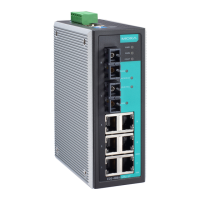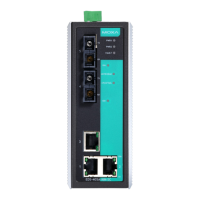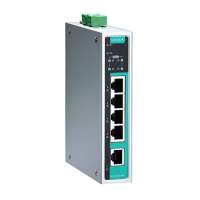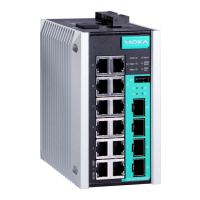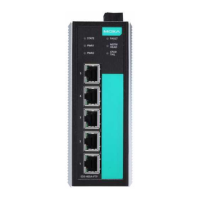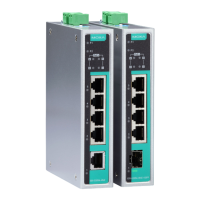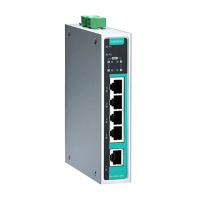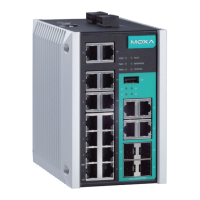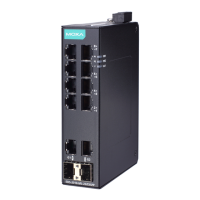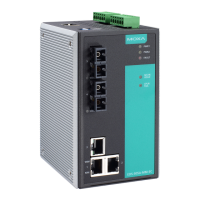
Do you have a question about the Moxa Technologies EtherDevice EDS-508A Series and is the answer not in the manual?
| Model/Series | EDS-508A Series |
|---|---|
| Type | Managed Ethernet Switch |
| Switching Capacity | 1.6 Gbps |
| MAC Address Table | 8K |
| Packet Buffer Memory | 1 MB |
| Jumbo Frame | 9216 bytes |
| Storage Temperature | -40 to 85°C (-40 to 185°F) |
| Humidity | 5 to 95% (non-condensing) |
| Ports | 8 x 10/100BaseT(X) |
| Standards | IEEE 802.3, IEEE 802.3u, IEEE 802.3x |
| Power Input | 12-48 VDC |
| Operating Temperature | -40 to 75°C (-40 to 167°F) |
| Enclosure | IP30 |
| Mounting | DIN-Rail mounting |
| Certifications | CE, FCC, UL |
Discusses the evolution and trends of Ethernet in industrial applications.
Introduces the Moxa EtherDevice Switch and its role in industrial environments.
Lists the items included in the Moxa EtherDevice Switch package.
Highlights the key features and capabilities of the Moxa EtherDevice Switch.
Details the steps for initial configuration using the RS-232 console port.
Explains how to access and configure the switch via Telnet.
Guides users on accessing and configuring the switch through its web interface.
Provides instructions on how to disable network access methods for security.
Covers essential system identification and network parameter configurations.
Details configuring IPv4 and IPv6 network settings for management access.
Explains how to set the system time, date, and time zone for accurate logging.
Describes how to configure basic settings using the physical DIP switches.
Outlines the process for updating system files using a TFTP server.
Explains how to export and import system configuration files locally.
Details using backup media for system configuration loading and saving.
Describes the function to restart the Moxa EtherDevice Switch.
Guides on restoring the switch to its original factory default settings.
Explains how to aggregate multiple links for increased bandwidth and redundancy.
Details configuring SNMP versions V1, V2c, and V3 for network management.
Covers SNMP version selection, community strings, and authentication types.
Configures SNMP trap and inform modes for event notification.
Provides information on private MIB files for extended SNMP management.
Explains setting up redundant network paths using various protocols like Turbo Ring.
Details the configuration process for the Moxa Turbo Ring protocol.
Outlines the configuration steps for the enhanced Turbo Ring V2 protocol.
Explains how to set up and manage devices in a chain topology for redundancy.
Introduces Spanning Tree Protocol and Rapid Spanning Tree Protocol concepts.
Guides on configuring STP and RSTP parameters for loop prevention.
Explains how to prioritize network traffic for improved performance and QoS.
Details the QoS classification and queuing mechanisms for traffic management.
Introduces Virtual LANs (VLANs) for network segmentation and efficiency.
Covers the process of managing VLANs, including naming and ID assignment.
Explains tagged vs. untagged VLAN membership for ports and links.
Provides practical examples of implementing VLANs in network scenarios.
Details the configuration of 802.1Q VLANs and port settings.
Explains how to filter multicast traffic to improve network performance.
Guides on setting up IGMP snooping to optimize multicast traffic delivery.
Details the configuration of GARP Multicast Registration Protocol for multicast management.
Covers controlling network bandwidth usage and preventing broadcast storms.
Explains methods for controlling access to network ports, like Static Port Lock and 802.1X.
Details the configuration of IEEE 802.1X for port-based network access control.
Guides on setting up a local user database for authentication.
Explains how to configure automatic warnings via email or relay output for system events.
Details the configuration of email settings for automatic warning notifications.
Guides on setting up relay outputs for warning notifications based on system events.
Describes the fast recovery function for device unplugging and replugging.
Explains how to automatically assign IP addresses to connected devices using DHCP/BOOTP.
Introduces tools for diagnosing network system issues.
Details setting up a mirror port for monitoring network traffic on a specific port.
Explains using the ping function for network troubleshooting and integrity checks.
Introduces the Link Layer Discovery Protocol for network topology discovery.
Describes how to enable, disable, and configure LLDP settings via the web interface.
Details the specific settings available for the LLDP protocol.
Explains how to monitor network statistics in real-time via the console or web interface.
Guides on monitoring network traffic activity on an individual port.
Explains how to view and manage the switch's MAC address table.
Details how to view the recorded system events and logs.
Explains configuring syslog servers to receive event logs.
Guides on securing HTTP access using HTTPS/SSL for encrypted traffic.
Provides instructions on how to launch the EDS Configurator software.
Explains using broadcast search to locate EDS switches on the LAN.
Details how to search for specific EDS switches using their IP addresses.
Guides on updating the switch's firmware to the latest version.
Explains how to reconfigure the IP address and other network settings for the EDS.
Details saving the switch's configuration to a text file.
Explains transferring a saved configuration file to the switch.
Describes the process of unlocking a password-protected switch for configuration.
Lists MIB variables related to the system's general information.
Details MIB variables for network interface statistics and status.
Covers MIB variables related to IP addressing and ARP tables.
Lists MIB variables associated with the Internet Control Message Protocol.
Details MIB variables for TCP connection and statistics information.
Covers MIB variables related to UDP datagrams and statistics.
Lists MIB variables for Ethernet transmission statistics.
Details MIB variables related to SNMP protocol operations and statistics.
Covers MIB variables for bridge-specific information, including STP and VLANs.
Provides Modbus/TCP register map for the EDS-505A model.
Provides Modbus/TCP register map for the EDS-508A model.

